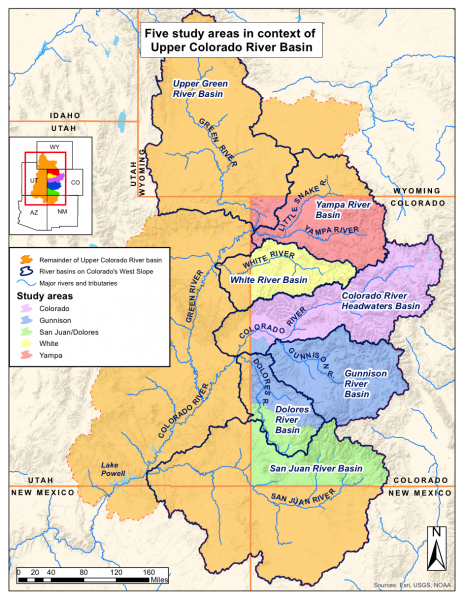Optimizing conservation planning and law for environmental water marketing in western Colorado
Project Leads
- Philip Womble
- Steven Gorelick and Barton (Buzz) Thompson

Background
Riverine ecosystems require proper quantity, timing, and quality of instream flows. Yet because water rights in the western United States historically existed only for diversionary uses, and not instream flows, the entire flow of many rivers in this region has been claimed for offstream uses. With instream flows left out of the equation, major waterways routinely run dry, or virtually dry, during substantial portions of the year.
Drought, climate change, and population growth increasingly stress western U.S. water supplies. Water markets enable adaptation by facilitating water transfers to higher valued uses, which may include instream flows, in times of scarcity. Prior appropriation water law, the dominant water law regime in the western U.S., establishes private property rights in water that are increasingly traded. State legislatures, courts, and agencies paved the way for environmental water marketing in the western U.S. through legal reforms that allow instream flow water rights. Environmental water marketing occurs when water users permanently or temporarily transfer existing consumptive water rights to nonconsumptive, instream use. Because environmental water marketing maintains the original priority of the water rights transferred instream, it offers one of—if not the—most promising options for flow restoration in the western U.S.
Environmental water trading in the western U.S. has not been trivial. From 2003-12, total expenditures on water acquired to protect streamflows across the western U.S. exceeded $560 million. These environmental transactions represent 40 percent of the total volume of water traded in this same time period. And in 2012 alone, environmental water transactions added almost 1.3 million acre-feet of flows—almost 9 percent of the mean annual flow of the Colorado River—to streams in western states. This environmental market is most active in the Pacific Northwest, but nearly all of the western states report environmental water transactions (WestWater, 2014). Currently, however, organizations and agencies acquire instream flows opportunistically, obtaining water rights that are individual conservation priorities but that are likely suboptimal in aggregate.
Project overview
Against the backdrop of a growing market for environmental water rights in the western U.S., this research evaluates how more strategic acquisitions of water rights improve ecological outcomes from trading. Like a stockbroker who seeks to maximize financial returns from a portfolio of stocks, this research will identify portfolios of water rights purchases and leases that maximize ecological benefits with a given budget. This research studies environmental water marketing across five study regions in western Colorado (Figure 1), which collectively contribute about 75 percent of the Colorado River’s flow. These regions face heavy projected increases in water demands in coming years, both from anticipated native population increases and potential transmountain diversions to Denver and other growing municipalities on Colorado’s Front Range.
Goals
Responsive water markets provide a leading solution for increasing the drought resilience of economies and ecosystems throughout the West. Climate change is projected to alter traditional temperature, precipitation, and evapotranspiration patterns across the West, resulting in seasonal declines in streamflows for communities and freshwater ecosystems. Optimization-based conservation planning tools that work within existing water rights systems can help to improve ecological outcomes of water markets. Meanwhile, an improved understanding of how laws currently affect water marketing can suggest policy changes that promote flexible, adaptive water resources management in the West.
